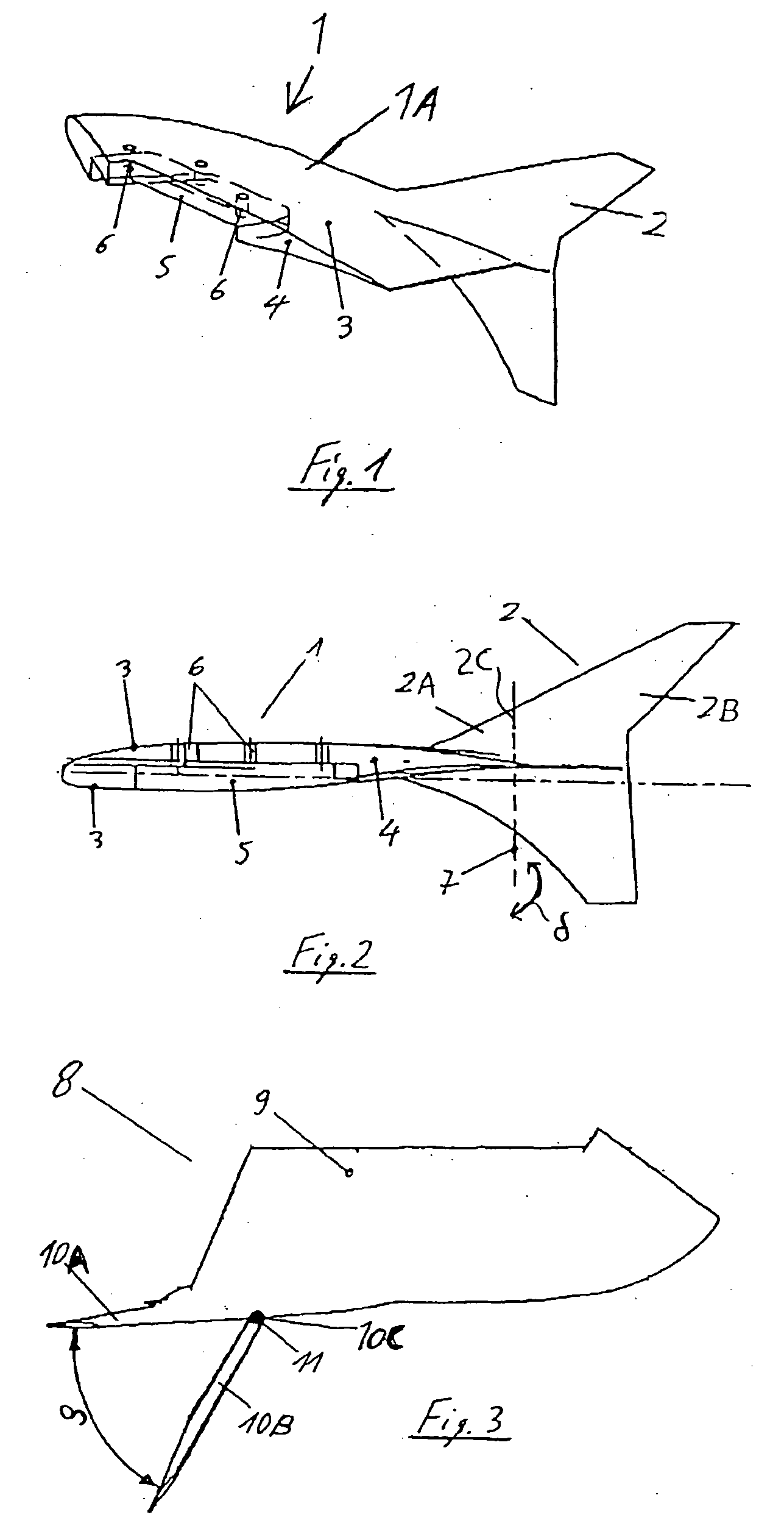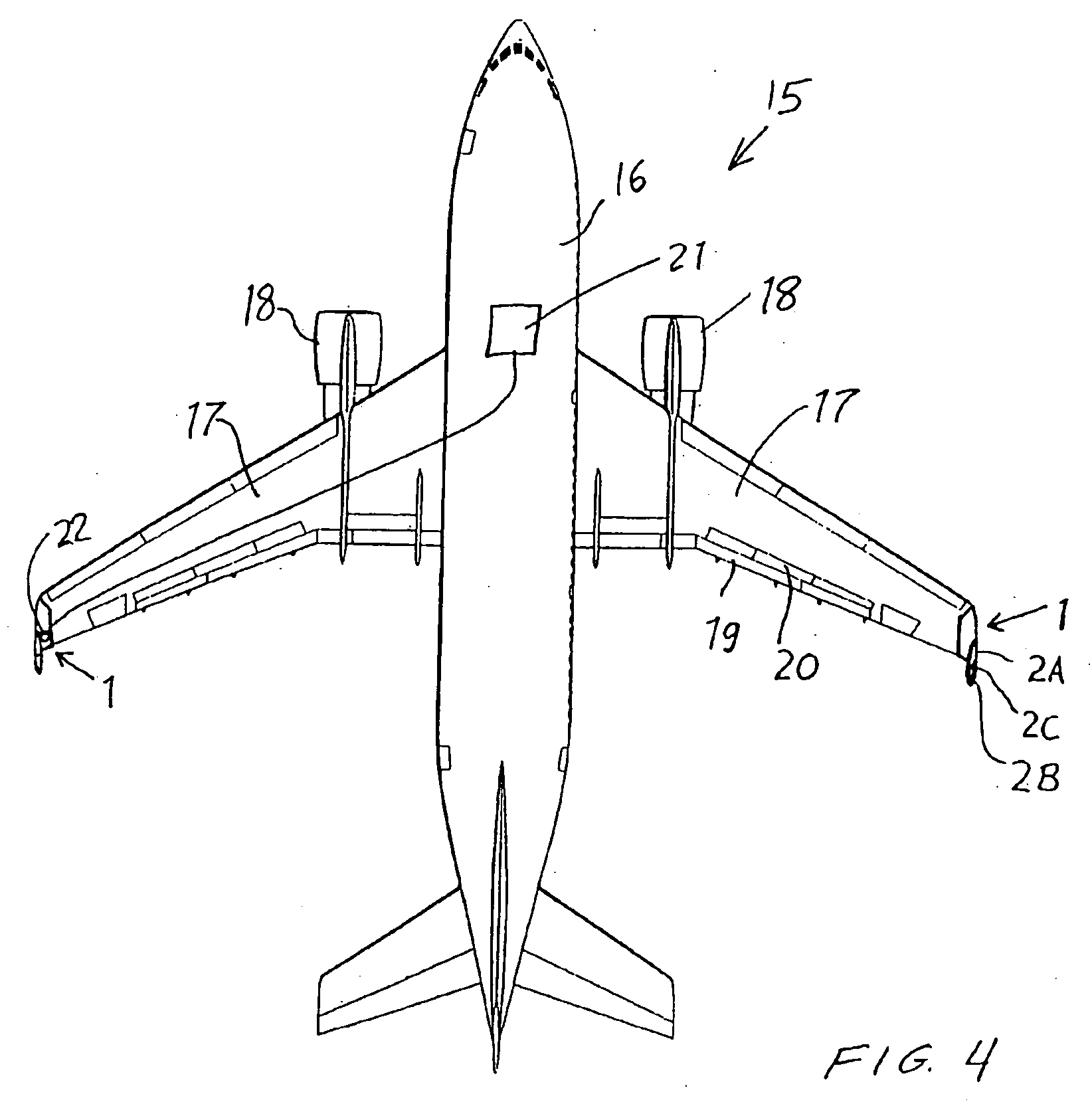[0008] The above objects have been achieved according to the invention in a device for controlling the landing approach of an aircraft, including a respective pivotable control element arranged respectively at the outboard wingtip of each wing of the aircraft. These pivotable control elements can be selectively pivoted to deflected positions, whereby the coefficient of lift of the aircraft is not influenced (i.e. remains essentially constant with no practically significant change), the coefficient of drag of the aircraft is altered, and the aerodynamic drag or flow resistance of the aircraft is increased. As a result, the glide path angle is made steeper, i.e. increased relative to the horizontal plane. Preferably, each pivotable control element is pivotally connected to a fixed plane or surface member, which in turn is rigidly connected to or a part of an aerodynamic component that is secured to the respective wingtip. The aerodynamic component may, for example, be embodied as a wingtip fence or a winglet, which is additionally provided with the pivotable control element. The pivot axis preferably extends perpendicularly to the major plane of the wing or parallel to the yaw axis of the aircraft.
[0009] The above objects have further been achieved according to the invention in a method of operating the inventive device, whereby the respective pivotable control elements on the wingtips of the two wings of the aircraft are pivotally deflected, mirror symmetrically in unison, so as to increase the total coefficient of drag, without exerting a net yaw influence on the aircraft and without influencing the total coefficient of lift. Thus, the pivotal deflection of the inventive control elements simply introduces an increased drag to the overall aerodynamic configuration of the aircraft, which thereby achieves a faster descent along a steeper glide path in a simply and finely controllable manner. Particularly, the pivotal deflection of the inventive control elements achieves a fine adjustment that is superimposed on the basic aerodynamic configuration of the aircraft that is set by the control adjustments of the general control surfaces or control elements such as the flaps, spoilers, engine thrust adjustment, etc. Furthermore, by carrying out rapid fluctuating deflections with a time varying deflection angle or magnitude of the pivotable control elements, a rapid collapse of the wingtip vortices can be achieved.
[0010] By making the gliding descent of the aircraft steeper and faster over a shorter horizontal distance along the glide path, the invention reduces the total time required for a landing process, and thereby increases the take-off and landing cycle time and throughput capacity of the airport. Moreover, the invention makes it possible to carry out a finely adjustable drag control of the aircraft with a large bandwidth or large range of control, while being essentially independent of the lift and other moments of the aircraft. The inventive control further makes it possible to reduce the flight noise of the aircraft, especially in the landing configuration.
[0012] The aerodynamic effect of the inventive control elements can be determined by model tests and measurements in a wind tunnel, whereby the determined test data can be used as the basis for integrating the inventive control elements into the overall flight control system of the aircraft. In other words, by providing the appropriate data that associates the control element deflection with the resulting aerodynamic effect thereof, the pivoting deflection of the inventive control elements can be readily controlled from the general flight control system of the aircraft, e.g. including a flight control computer. It is further advantageous, that the movable control elements can be controlled in a symmetrical and synchronized manner to achieve the above described glide path control without any yaw effect, but alternatively can be deflected independently and / or asymmetrically on the two sides of the aircraft so as to achieve a yaw control. This effect is especially advantageous in emergency situations such as an emergency descent of the aircraft and / or in the event of an engine failure, to support and supplement the other conventional control devices for maintaining the yaw control of the aircraft.
[0013] Appropriate actuation of the inventive pivotable control elements contributes to a rapid collapse of the trailing vortices of the wingtips of the aircraft. This is especially advantageous because then a shorter spacing (in time and distance) may be maintained between a respective aircraft taking off or landing and the next successive aircraft that can take-off or land, in view of the rapid collapse of the trailing vortices of the preceding aircraft. Thereby, a further increase of the take-off and landing rate can be achieved.
 Login to View More
Login to View More  Login to View More
Login to View More 


